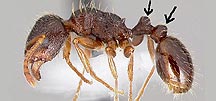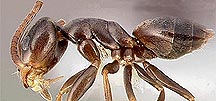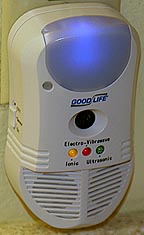

Wayne Schmidt's Ant Wars Page! Comparing methods for driving them out of your house.
They
appear every April in my kitchen: tiny ants crawling over counters.
It doesn't matter how clean the kitchen is they just keep on
returning. While their numbers aren't great, like cockroaches it
doesn't take very many to make your skin crawl. I had to find a way
to get rid of them.
That's what this page is about: my battles with ants to chase them out of my house once and for all. I'm posting a chronicle of this ant war in the hope that it helps other victims of these 6-legged pests.
As any military general will tell you, the first step in any war is to "know your enemy."
There are hundreds of varieties of ants from 2-inch monsters in the tropics with stings so virulent it makes skin feel like it's on fire to almost microscopic varieties. Ants are one of the most successful and numerous animals on the planet. They've been around over 100 million years, survived planet-wide extinctions and number in the many hundreds of billions world-wide. A single colony can top 1,000,000 individuals and produce more members every than even the most determined Raid sprayer has strength in an index finger to kill. Some species even form super-colonies with multiple queens. Their borrows are master feats of engineering design, many times reaching down over six feet. They can lift ten times their body weight (the same as the average human lifting almost a ton) and run at a scaled speed (compared to a human) of 130 miles per hour. It's fortunate they're as small as they are or they would long ago have taken over the earth.
So much for generalities. The question now is: What variety of ant is plaguing my kitchen?
Specific species are identified by size, color location, antenna shape, and the number of nodes on the connection between the thorax and abdomen.

The ant above is a common pavement ant and is easily identified by the two nodes, indicated by the black arrows, on the thorax/abdomen connector.
Here's a close-up of one of the ants invading my kitchen.

The Internet has many ant-identification sites. Using one of them I was able to determine that my ant is the most common house-invading type: the odorous house ant. Besides the size (less than 1/8th-inch), color (dark brown) and the fact that they give off a coconut-like odor when crushed, the main identifying factor was that they only have one node and it's hidden.
The enemy is now known.
Unfortunately, while this allowed me to learn a lot about them this knowledge ended being useless.
Odorous house ants are tiny, have no stingers and their jaws are too small to bite human skin. They live in large multi-colonies where there can be several queens. These colonies may be located either under the house or far from it. It's entirely possible that the ants invading one house actually live in a neighbor's yard and commute to your house. While they are active 24 hours a day, I find ten times as many at night as in daylight hours. They are also seasonal, at least in my high desert location. While individuals can be found all year long, comparably few are seen from late Fall through early Spring. Although they eat almost anything they find they prefer damp or liquid sweets.
Let
the war begin!
The first and most important step was prevention. I made sure that the kitchen was kept scrupulously clean at all times. One tiny spot of grape jelly is enough to attract them in hordes. The real danger in this situation is that they leave chemical markers to lead other ants to the feast. These markers resist both time and cleaning. Fortunately, I'd been doing this for some time so there were no such trails. All I had were ants randomly searching for food.
Next I tried spraying the border of my house with a long-lasting ant killer. One year this tactic helped. The next it actually made things worse. I interpret this change to be caused by the ants moving their nest under the house and therefore inside the poisonous barrier.
I followed this with spraying all the places I could find inside the house where the ants entered and their most common paths. This didn't provide any permanent protection. They simply found new entry points and established new paths. I tried various ant powders and they also failed to have any lasting effect. Besides not working very well there are other problems with such measures. They have to be reapplied after every cleaning and may leave dangerous residues that could harm children or pets.
(I considered hiring a professional insect killing service. While most such services guarantee their work, I was concerned about the strength of the sprays they use and how it might effect the soil. Also, if the ants are under the concrete slab on which my house sits and are coming into the house through cracks in the concrete, spraying the outside won't have any effect.)
Following these failures I decided to use the ant's major weakness against them: their stupidity. As successful as they are, ants aren't intellectually gifted. If they find food they like they will eat it and take it back to the nest to share with their queen. If this food happens to contain some poison they will continue bringing it back even while watching their nest dwindle and die.
The most common such poison is boric acid. Mixed at a 0.5 to 1.0-percent solution with sugar water it creates a weak poison that's so slow acting it gives time for workers to collect it and carry it back to the nest to feed it to others and most importantly, the queen. There are several different forms of boric acid, some of which are better for killing ants than others. The best course of action for this purpose is to go on-line and order a solution specifically prepared for killing ants. I selected one and tried it, establishing an out-of-the-way feeding location where the ants could come and go without being seen by house guests. This type of slow poison takes two weeks or more to work so patience is required. And work it did!
In my case I noticed a sudden drop off in the number of ants coming to feeder in three weeks. By the end of the month they were completely gone. Success! I'd defeated the enemy!
Or so I thought.
A month later I woke up to discover ants all over the kitchen. Either the first nest had recovered or a new one had moved in. Either way, the ants of the first nest had left strong markers telling any future ants that my house was a reliable source of food. The weakness of these slow-acting poison strategies is that the trails left by the ants can lead other colonies into the house long after the first colony has perished. Besides that, maintaining a feeding point gets to be a hassle and embarrassing to explain to guests. Clearly, I needed something better. I found it.
I'd heard about small electronic units that are plugged into a wall socket and emit ultrasonic sound that repels ants. An extensive Internet search turned up half a dozen such devices averaging $40 each. Testimonials about these devices was mixed, with some people claiming that they were extremely effective but others stating that the same models were worthless. Additionally, the federal government has stated that the effectiveness of these devices has not been proven in the home setting. With so many contradictory claims being made it was difficult to decide if I should get one.
Then the ants decided the issue for me. The very next day I woke up to 60 ants crawling over the kitchen counters. I decided to gamble $40 to see if one of the ultrasonic ant-chased could help. But which on to get?
I located a forum-type webpage attached to an on-line retailer of many different types of these devices where people could write in with descriptions of how well one particular device or another worked. Combing through these posts I found that the one device with the most positive comments was the Pest Repeller Ultimate AT, by Good Life LLC.

I say "best" in a strictly comparative sense. Only half of the posts said it worked. However, all of the other repellers received considerably lower ratings by in-home users. The manufacturer claims it respells insect pests three ways: by emitting ions, sending electronic signals through the house's wiring and releasing ultrasonic beeps that ants hate.
My unit arrived in a few days but I resisted the temptation to plug it in.
All of the claims I'd read about this device working or not working were anecdotal: people just said is worked or didn't without any quantitative data. I wanted more so for a week before plugging it in I counted the number of ants discovered an particular locations at specific times of the day. Then I plugged the unit in and repeated the ant count to measure what effect it had. First up was a small bathroom.
day
1: (no repeller) 7 ants
day
2: 6 ants
day
3: 9
day
4: 4
day
5: 15
day
6: 14
day
7: 8
day
8: 13
On the night of the 8th day I plugged the repeller in and counted the ants in the same way starting with day 9.
day
9:.. 2 ants
day
10: 2
day
11: 0
day
12: 1
day
13: 3
day
14: 4
day
15: 5
day
16: 5
day
17: 2 ants
While the device didn't completely get rid of the antS it appeared to help. However, it's possible that the reduction simply reflected an unrelated change in the ant's behavior. To test this I removed the repeller and again counted ants.
day
18: 3 ants
day
19: 6
day
20: 5
day
21: 8
day
22: 7
day
23: 10
day
24: 14 ants
This increase seems to support the claim that this device does indeed repel ants, though not as completely as one would wish.
Next I repeated this same test in the kitchen.
day
1: (no repeller) 39 ants
day
2: 30
day
3: 29
day
4: 64
day
5: 15
day
6: 7
day
7: 28
day
8: 15
day
9: 11
day
10: 58
day
11: 23
day
12: 61
day
13: 51
day
14: 29
day
15: 28 ants
I waited twice as long before plugging in the repeller because there appeared to be a wider spread in the daily number of ants and I wanted to get a longer baseline reference. On the evening of the 15th day I plugged to repeller in.
day
16: 2 ants
day
17: 1
day
18: 16
day
19: 4
day
20: 6
As in the bathroom, using this repeller seems to reduce, though not eliminate, the number of ants coming into the kitchen. As in the bathroom test, I next removed the repeller to see if the ants count increased again, which would further verify it's efficacy. Unfortunately by this time it was Fall and an early cold snap hit my area. This typically reduces the number of ants coming into the house so the test had to be terminated until next Spring... if and when the ants return.
Closing thoughts:
It appears that at least in my situation the repeller I purchased had some positive effect and I will continue to use it. If you've tried them without success it may be because the unit was defective or was used in a manner that prevented it from working. For example: the bathroom in the first test was very small so the ultrasonic sound was concentrated in a small area. Placed in a larger room the sound will quickly disburse to the point where it's not loud enough to have any effect. Many repellers may be needed in such a situation. The kitchen in the second test was also small and the repeller was aimed directly at the location where the ants came in. In addition, the door to the kitchen was closed at night to further concentrate the unit's effectiveness. If it had been plugged in facing an open door, or worse still out into the dining/living room in an open floor plan house, the sound would again quickly dwindle to the point where it had no effect on the ants.
I've ordered three more of the repellers. Next year I'll wait to verify and measure the ant's return then place one unit in the bathroom and three in the kitchen and see if more repellers flood the rooms with enough ultrasonic sound to reduce the ant count even more. Please check back next Spring to see how the next phase in my ant war turns out.
IMPORTANT UPDATE!!!
Unfortunately the ants never came back to the kitchen in 2008 so I couldn't test the ant repellers there. However, we did discover a small ant trail in one of the bedrooms. Someone had dropped a few bread crumbs near a wall and the ants found it. There were only six ants feeding and only 4 more slowly working their way along the trail to the crumbs. This suggests that they had only recently discovered it and while the find had been marked for feeding the nest hadn't yet gotten aggressive about it. This is a perfect situation for testing the ant repellers
I vacuumed up all the crumbs but was careful to avoid disturbing the ant trail. I then positioned two of the ultrasonic repellers in the area, one three inches from the ant's entry point and a second sited down the two foot long extent of the trail. Furniture was then moved back in place to enclose the repellers as much as possible. Because of this the strength of the signal was confined to a much smaller volume than typical. Under these conditions the repelling force could easily be hundreds of times stronger than usual.
The results: nothing. I counted an average of 8 ants per minute before the repellers were in place. Each day for the next three days the counts at the same time of day were: 8 ants per minute, 6 ants per minute, and 7 ants per minute.
Even though the lights on both repellers were working, it's possible one of them was defective but highly likely that both could be. This test suggests that this brand is not as effective at keeping ants out of a house as the initial tests suggested. I have no explanation for this.
Return to my main page and browse 100 other topics: everything from kaleidoscopes and metal detectors to the strange world of lucid dreaming.